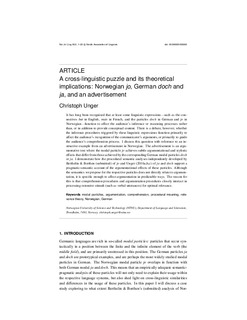A cross-linguistic puzzle and its theoretical implications: Norwegian 'jo', German 'doch' and 'ja', and an advertisement
Journal article, Peer reviewed
Accepted version
Permanent lenke
http://hdl.handle.net/11250/2587791Utgivelsesdato
2018Metadata
Vis full innførselSamlinger
Sammendrag
It has long been recognised that at least some linguistic expressions – such as the connectives but in English, mais in French, doch in German and jo in Norwegian – function to affect the audience’s inference or reasoning processes rather than, or in addition to provide conceptual content. There is a debate, however, whether the inference procedures triggered by these linguistic expressions function primarily to affect the audience’s recognition of the communicator’s arguments, or primarily to guide the audience’s comprehension process. I discuss this question with reference to an instructive example from an advertisement in Norwegian. This is an argumentative text where the modal particle jo achieves subtle argumentational and stylistic effects that differ from those achieved by the corresponding German modal particles doch or ja. I demonstrate how the procedural semantic analyses that we have developped in the NOT project (Berthelin & Borthen 2015 on jo, Unger 2016a on ja and doch) support a pragmatic-semantic account of the argumentational effects of these particles. Although the semantics we propose for the respective particles does not directly relate to argumentation, it is specific enough to affect argumentation in predictable ways. The reason for this is that comprehension procedures and argumentation procedures closely interact in processing ostensive stimuli (such as verbal utterances) for optimal relevance.
